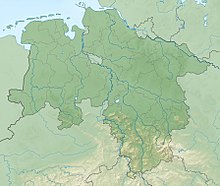Burial mound in the Postels bush
Coordinates: 53 ° 41 ′ 59 ″ N , 9 ° 7 ′ 17 ″ E
The grave mounds in Postels Busch (also called Wunnerborn) were a remarkable group of mounds . It was in the Feldmark near Hemmoor- Westersode, in the district of Cuxhaven in the Elbe-Weser triangle in Lower Saxony .
description
On the top of the Geest there was a row of hills consisting of five hills that were destroyed during cultivation in 1931 and 1935. The amateur archaeologist W. Klenck, who carried out emergency rescues in the hills in 1931 and 1935, provided information about the hill group. Their dimensions were (from west to east):
- a) height 2.20 m, diameter 18 m;
- b) height 1.00 m, diameter 10 m;
- c) height 1.00 m; Diameter 12 m;
- d) height 2.30 m; Width 16 m; Length 30 m,
- e) Height 1.90 m, diameter 15 m.
The hill d) was one of the rare Bronze Age long hills, like the "Long Mountains" of Langen , Debstedt and Heerstedt. According to Klenck's observations, the long hill d) contained 18 stone settlements, four of which were the stone packings of graves without graves. In the hill he found a bronze short sword and a serrated spearhead . Like many others, these mounds also had several Late Bronze Age and Iron Age follow-up burials as urn burials .
Hill A
Burial mound a) turned out to be the richest and youngest. In it Klenck found a central grave and a north-south facing male grave, as well as a west-east facing female grave, both in the northern half of the hill. The woman was buried in a tree coffin. Her additions consisted of a wide finger ring, a 10.5 cm long disc-headed needle with a perforated shaft and a small, thin bronze needle. There was still a remnant of a finger bone in it.
The stone setting
The men's grave yielded an unusual finding: under a stone packing 2.0 m long, 0.9 m wide and 0.95 m thick, a roughly box-shaped stone setting with internal dimensions of 1.05 × 0.55 m was only 0.15 m height. One narrow side was formed by a plate, the rest consisted of 19 stones about the size of a head. Corpse burns were scattered all over the inner surface. Embedded in the center was a 56 cm long hilted sword with a rhombic decorative pommel, a square chape and the remains of the wooden scabbard. The stone setting also contained an 11 cm long needle with a stepped head, a slightly sickle-shaped curved bronze knife with a cut-out handle, a narrow bronze strip and a small handled vessel.
Klenck found the oldest body grave in hill e). It contained an early Bronze Age flint dagger and a winged arrowhead .
classification
While the woman's body grave could have been placed in period II of the Bronze Age, the man's grave belongs to period III, in which cremation spreads. The hill was thus “biritual”, with body and cremation burials that either took place at the same time or followed one another at shorter intervals.
The finds from the hills of "Postels Busch" are in the Lamstedt Bördemuseum.
Web links
- TK25 sheet 2220 Kadenberge (1925) - next to the word Cement there is a burial mound (?) On the edge of the excavation.
literature
- Wilhelm Klenck: Prehistoric sites of the Börde Lamstedt . Yearbook of the Men from Morgenstern 23 (1926-28) 49–91.
- G. Jacob-Friesen: The cultural and temporal classification of the finds from Westersode . In: Die Kunde NF 7 1956 pp. 12-14.
